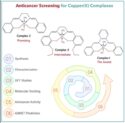Photoactive iron–naphthalene complexes enable fast, environmentally friendly curing of even dark-pigmented alkyd paints

🧪 Article Highlight: Light-Activated Iron Catalysts for Efficient Curing of Dark Alkyd Paints

Chirality Unveiled in DNA by Terahertz ROA
This study reveals spontaneous chirality in guanosine G-quadruplexes using terahertz ROA, offering insight into life's origins and bioanalysis.

Chemistry Europe’s Top Summer 2025 Book & Podcast Picks
What to read or listen to this summer? I have asked members of the Chemistry Europe community to recommend enjoyable science-themed books and podcasts

Porphyrin Nanodots Target Breast & Cervical Tumors
Methoxy-porphyrin nanophotosensitizers show promise in photodynamic therapy, selectively attacking breast and cervical cancer cells with precision

Copper-Salen Complex Shows Promise as Safer Cancer Agent
A new copper-salen complex targets cancer cells with reduced harm to healthy cells, offering a potential alternative to traditional chemotherapy drugs

Iron Boosts BODIPY Heat Power for Cancer Light Therapy
Iron-enhanced BODIPY photosensitizer boosts heat generation, offering a powerful new approach for deep-tissue photothermal cancer therapy

🧪 Article Highlight: Planar Tetracoordinate Fluorine in Binary Clusters
First examples of planar tetracoordinate flourine atoms in binary M₄F₄⁻ (M = Li, Na) clusters have been predicted using quantum chemical methods

AI Drug Hunt Reveals Promising Alzheimer’s Leads
AI meets chemistry to uncover potent AChE inhibitors; six new molecules could pave the way for safer, more effective Alzheimer’s treatments.

Sulfur-Rich Network Polymers via Dynamic C–S Bonding
Max von Delius, Kerstin Leopold, and colleagues developed sulfur-rich network polymers that show excellent metal sorption and battery cathode performance

Antibacterial Patches Using Melaleuca Oil Nanoemulsions
Antibacterial patches made with Melaleuca oil nanoemulsions in Pec:PVA films offer a natural, safe, and long-lasting solution for infected wound care